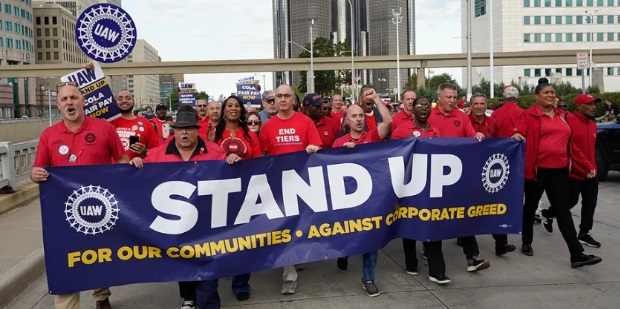Organizing and providing security for a corporate strike involves ensuring the safety of both the striking employees and the corporation’s property and personnel. It is essential to have a well-planned strategy to avoid any sort of violence, vandalism, or other form of misconduct.
Integrous Risk Solutions recently provided security for the largest nursing strike in the history of the United States healthcare industry. The strike, consisting of 15,000 nurses and 16 hospitals throughout the state of Minnesota, commenced on September 12, 2022 after the staff demanded a 30% wage increase over three years.
Safety and security are of utmost concern in the course of a large corporate strike, and many unique factors need to be considered, especially given the emergent nature of the decision-making process. During the previously mentioned healthcare strike, for instance, nurses had to be flown into Minneapolis from all over the United States, occupying approximately 24 hotels and requiring 24 busses for transportation. This scenario, because of the vast potential for threats and vulnerabilities, required both extra security at the hotels and during the nurses’ transport from the hotels to the hospitals.
In addition to the need for secured escort of the nursing staff to and from work, extra consideration for the nurses’ safety while at work was also crucial. The nature of the strike required this interim nursing staff to fill in for the resident nurses, enabling them to strike outdoors alongside their coworkers. In order to protect the group protesting, security was therefore needed both inside and outside of the hospital and among the parking decks.
The number of security agents needed to meet these requirements multiplied quickly, and all the “moving pieces” required to support the extra security at the hotels, during transport, and at the hospitals quickly turned into a large expense.
Because the healthcare industry requires 24-hour shift coverage, in order to provide adequate protection, security must also cover all 24 hours of shifts, thus requiring the security agents to run 12-hour shifts. This means if the security project calls for 28 positions, a minimum of 56 protective agents are required to cover the project. This number does not take into consideration such factors as overtime and compliance with various state and federal labor laws.
Security needs also expand beyond those of the staff members, hospitals, hotels, and buses. In a volatile environment such as a large corporate healthcare strike, consideration also needs to be given to the security of executives of the hospital and hospital group.
Because the primary key factors in an employee strike such as this often involve the employees’ unhappiness with the company’s position on emotionally-charged issues such as employee contracts and salaries, a safety and security plan must include provisions for residential security for key executives for the duration of the strike. Executives may also need to consider working from home during this time or plan for executive protection while in the office and while traveling to and from work.
As you think about all these factors, let’s dive into the process of planning and executing a successful strike security operation. Here are the steps you can take for providing security during a corporate strike:
Step 1: Preliminary Analysis
1.1 Risk Assessment
- Threat Analysis: You must conduct a complete security assessment and identify potential threats and vulnerabilities that need attention both prior to and during the strike.
- Impact Assessment: Evaluate the potential impact of the strike on the organization’s operations.
1.2 Legal & Compliance Review
- Labor Laws: Understand the local labor laws and regulations governing strikes.
- Permits: Ensure necessary permits are acquired for peaceful protests.
Step 2: Planning & Coordination
2.1 Coordination with Law Enforcement
- Liaison: Establish a liaison with local law enforcement agencies in the event a situation escalates and needs law enforcement support to resolve the situation.
- Emergency Response: Coordinate with law enforcement for potential emergency responses.
2.2 Stakeholder Communication
- Internal Communication: Develop a communication plan to keep internal stakeholders informed.
- External Communication: Establish channels for communication with union representatives or striking employees, which is especially important as they work toward a contract agreement.
Step 3: Security Measures
3.1 Physical Security
- Perimeter Security: Strengthen the perimeter security of the corporate facility to prevent unauthorized access.
- Access Control: Implement access control measures to secure sensitive areas.
3.2 Personnel Security
- Security Personnel: Deploy trained security personnel to maintain peace and order.
- Crowd Management: Develop strategies for crowd management to prevent any incidents.
Step 4: Strike Day
4.1 Surveillance
- CCTV Surveillance: Enhance CCTV surveillance to monitor the situation closely.
- Reporting: Establish a system for immediate reporting of any incidents.
4.2 Conflict Resolution
- Negotiation Teams: Have negotiation teams on standby to resolve conflicts amicably.
- Peaceful Dialogue: Promote peaceful dialogue between the management and the strikers.
Step 5: Post-Strike Actions
5.1 Debriefing
- Incident Report: Prepare detailed incident reports if any incidents occurred during the strike.
- Feedback and Lessons: Gather feedback and lessons learned to improve future responses.
5.2 Reconciliation and Healing
- Reconciliation: Facilitate reconciliation processes to mend relationships post-strike.
- Counseling: Offer counseling services to employees, if necessary, to heal from the experience.
Step 6: Continuous Improvement
6.1 Policy Review
- Policy Review: Review policies to prevent recurrence and improve labor relations.
- Training and Drills: Conduct regular training and drills to ensure readiness for any future events.
6.2 Community Engagement
- Community Engagement: Engage with the community to build better relations and understand their concerns.
Step 7: Documentation and Reporting
7.1 Documentation
- Documentation: Maintain detailed documentation of all actions taken and incidents recorded.
- Reporting: Regularly report to the higher management and concerned authorities about the status and developments.
7.2 Evaluation and Improvement
- Evaluation: Evaluate the performance of the security measures implemented.
- Improvement: Identify areas for improvement and make necessary adjustments to the security plans.
Implementing these steps meticulously can help ensure that the corporate strike remains peaceful and that the security of individuals and assets is always maintained. It’s important to maintain an approach that is both firm and fair, respecting the rights of the strikers while also protecting the organization’s interests.
Integrous Risk Solutions is readily available to support your organization with a security assessment and the delivery of a successful security operation. Feel free to email us at nrabenau@integrousrisksolutions.com or visit our website at www.integrousrisksolutions.com.



